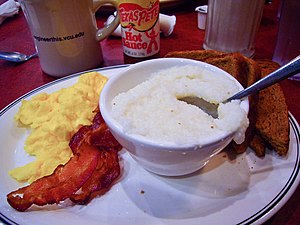Grits
 | |
| Place of origin | United States |
|---|---|
| Serving temperature | Hot |
| Main ingredients | Corn |
| Variations | Hominy grits Yellow speckled grits |
| Other information | Soul food |
Grits is an aboriginal American corn-based food common in the Southern United States, consisting of coarsely ground corn.
Grits is similar to other thick maize-based porridges from around the world such as polenta. It also has a resemblance to farina, a thinner porridge. The word leads back to the traditional Northern European grit gruels. Grits can be served hot or cold and as a base for a multitude of dishes from breakfast to dessert, depending on the additives. Additives can include salt and butter, meats (especially shrimp on the east or gulf coast), cheese, rarely (but in nouvelle Southern cuisine) vegetables, and sugar. It is also common for people from above the Mason-Dixon Line to have sugar with their grits.
Hominy grits is grits made from nixtamalized corn, or hominy. It is sometimes called sofkee or sofkey from the Creek word.[1][2]
Origins
Traditionally the corn for grits is ground by a stone mill. The results are passed through screens, with the finer part being corn meal, and the coarser being grits. Many communities in the U.S. used a gristmill up until the mid-20th century, with families bringing their own corn to be ground, and the miller retaining a portion of the corn for his fee. In South Carolina, state law requires grits and corn meal to be enriched, similar to the requirements for flour, unless the grits is ground from corn where the miller keeps part of the product for his fee.[3]
Three-quarters of grits sold in the United States is sold in the South stretching from Texas to Virginia, also known as the "grits belt".[4] The state of Georgia declared grits its official prepared food in 2002.[5] Similar bills have been introduced in South Carolina, with one declaring, "Whereas, throughout its history, the South has relished its grits, making them a symbol of its diet, its customs, its humour, and its hospitality, and whereas, every community in the State of South Carolina used to be the site of a grits mill and every local economy in the State used to be dependent on its product; and whereas, grits has been a part of the life of every South Carolinian of whatever race, background, gender, and income; and whereas, grits could very well play a vital role in the future of not only this State, but also the world", if as Charleston's The Post and Courier proclaimed in 1952, "An inexpensive, simple, and thoroughly digestible food, grits should be made popular throughout the world. Given enough of it, the inhabitants of planet Earth would have nothing to fight about. A man full of grits is a man of peace."[6]
Yellow grits include the whole kernel, while white grits use hulled kernels. Grits is prepared by simply boiling the ground kernels into a porridge; normally it is boiled until enough water evaporates to leave it semi-solid.
Use as ant killer
Dry grits can be used to kill ants. Simply put instant grits around ant dirt mound on a sunny day. The grits are eaten by ant and expand inside the ant's gut which is eventually blew up.[7] It can kill the ant colony in 48 hours.[8] It can also kills ducks and geese in a similar way.
See also
References
- ^
Hudson, Charles. "A Conquered People". The Southeastern Indians. The University of Tennessee Press. p. 498.
{{cite book}}: Unknown parameter|origdate=ignored (|orig-date=suggested) (help) - ^ Encyclopedia of Oklahoma History & Culture, entry "Sofkey", retrieved 18 Aug 2008
- ^ South Carolina Code of Laws, Title 39 - Trade and Commerce, Chapter 29, retrieved Dec 14, 2007
- ^ Charles L., Cutler (2002). Tracks that speak: the legacy of Native American words in North American culture. USA: Houghton Mifflin. p. 28. ISBN 0618065105., retrieved Oct 25, 2009
- ^ Georgia Secretary of State, State Prepared Food, retrieved Dec 14, 2007
- ^ South Carolina General Assembly 113th Session, 1999-2000, Bill Number: 4806, retrieved Dec 14, 2007
- ^ "Ants: Indoor and Outdoor. FACTSHEET FROM SAFER PEST CONTROL PROJECT". Retrieved 25 Oct 2009.
- ^ Nelson, Doyle (27 Nov 2007). "Amazing Non-toxic Organic Ant Killer". Retrieved 25 Oct 2009.
{{cite web}}: Check|authorlink=value (help); External link in|authorlink=
External links
- Grist Mills, Grits Festivals, Recipes, and Photos - SCIway.net, South Carolina Information Highway
